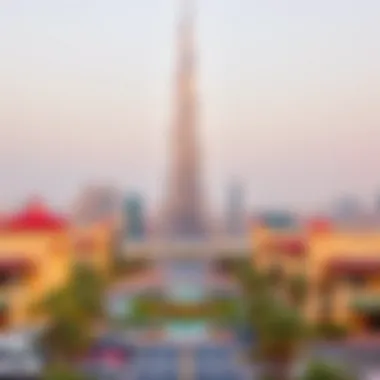Comprehensive Guide to the Dubai Zones Map


Intro
Navigating the bustling landscape of Dubai requires not just ambition but also a clear understanding of its geography, especially when it comes to real estate. The layers of the Dubai zones map offer an indispensable tool for those looking to tap into one of the most dynamic property markets in the world. This guide will break down the various zones within Dubai, shedding light on their unique characteristics, cultural contexts, and regulatory frameworks. With a nuanced grasp of these zones, potential buyers, investors, and realtors can make more informed decisions and seize opportunities that align with their ambitions.
Market Trends
Current Real Estate Market Insights
The Dubai real estate scene is a living entity, ever responsive to economic shifts and demographic changes. As of late 2023, the market has shown signs of resilience, bouncing back from the pandemic blues with a surge in demand for both residential and commercial properties.
The areas that are gaining particular traction include:
- Dubai Marina: Known for its stunning skyline and waterfront living, it's drawing in luxury buyers and renters.
- Jumeirah Village Circle (JVC): This zone is attracting a mix of families and young professionals due to its value-for-money aesthetic in a growing community.
- Downtown Dubai: Home to the iconic Burj Khalifa, this area continues to be a hotspot for upscale living and high-end businesses.
Future Predictions and Investment Opportunities
Looking ahead, industry experts predict that the Dubai real estate market will continue its upward trend, driven primarily by an influx of expatriates and tourists seeking both leisure and work in this vibrant city. Potential areas for investment include:
- Dubai South: Over time, this area is expected to flourish with the expansion of the Expo 2020 legacy projects.
- Mohammed Bin Rashid City: Focused on building a luxurious lifestyle with villas and retail hubs that cater to high-net-worth individuals.
According to a recent report on Dubai's market dynamics the focus over the next few years will be on sustainability and smart city features.
"Understanding the regulatory environment and zone specifics will be a crucial factor in successful investments."
Investors stand to gain significantly by aligning their purchase strategies with these emerging trends, particularly in zones that offer unique incentives or favorable regulations for property development.
Property Listings
Featured Luxury Properties
In the world of opulence, Dubai doesn't fall short. The city boasts some eye-popping luxury properties including:
- The Palm Jumeirah: Exclusive villas with private beaches that cater to the ultra-wealthy.
- One Za'abeel: A landmark skyscraper offering unparalleled views and high-end amenities.
Affordable Housing Options
It's not all about extravagance though. For first-time buyers or those on a tight budget, there are solid options available:
- Al Furjan: A community designed for families, known for more affordable townhouses.
- Discovery Gardens: A popular choice for expatriates; offers budget-friendly apartments amidst lush greenery.
With the right insights and a keen eye for the evolving market landscape, buyers can find advantageous opportunities across the spectrum, from luxury to affordable housing, ensuring there's something for every investor's taste.
For more information on specific listings, visit this tailored resource to stay updated on the latest offerings in Dubai's real estate market.
Overview of the Dubai Zones Map
Understanding the layout of Dubai through its zones map is crucial for anyone looking to navigate the city’s real estate landscape. The zones map serves as a visual guide that delineates various areas dedicated to residential, commercial, and recreational purposes. Knowing how this map operates not only aids in identifying investment opportunities but also influences location choices for new homebuyers, business establishments, or tourist attractions. In a city where strategic land use can make or break ambitions, such a resource is invaluable.
Furthermore, the zones map encapsulates the city's dynamic nature and its intentions for growth, providing stakeholders with insights into potential development trends. For example, when an area is earmarked for luxury residential developments, it hints at rising property values and burgeoning demand. Therefore, having a clear understanding of this map helps in making informed and strategic decisions.
Purpose and Importance
The primary purpose of the Dubai zones map is to categorize the city’s diverse neighborhoods into identifiable zones. This is not just about geographical boundaries—it reflects the social fabric and economic dynamics of each area.
- Investment Decisions: For investors, the zones map is a roadmap to lucrative opportunities. It helps identify which regions are primed for growth and which ones may be stagnating.
- Adaptive Planning: Real estate developers and planners can leverage the insights from the zones map to tailor developments that meet specific community needs. This focus on adaptability allows for a more effective response to market demand.
- Regulatory Compliance: Understanding the zones is essential for navigating the regulatory landscape in Dubai. Each zone has its own set of rules and regulations that govern what can be built or how properties can be used. Thus, knowing where these delineations lie aids in avoiding potential legal headaches.
The significance of the map extends beyond business and investment; it encompasses lifestyle choices as well. Residents need to understand how zoning affects everything from schools and parks to retail options and transportation channels. Ultimately, this resource provides clarity on the city's complex layout and assists in making quality decisions about living and working in Dubai.
Key Features of the Zones Map
The Dubai zones map is not merely a two-dimensional representation; it carries a wealth of information packed into a single visual tool. Here are some key features:
- Color-Coded Zones: Each zone is represented in distinct colors, making it easy to identify different types of areas at a glance—be it residential, commercial, or tourism-focused.
- Land Use Designations: Each area’s primary function is clearly marked, ensuring users can quickly ascertain what to expect. For example, some areas are exclusively for commercial use while others support mixed developments.
- Overlay of Resources: Certain versions of the map provide added layers, such as public transport routes, major landmarks, and schools, giving users a comprehensive overview of each zone and its accessibility.
- Dynamic Updates: The map is regularly updated to reflect changes in land use regulations or newly identified development zones, thus promising a current reflection of the rapidly evolving city.
Understanding these features allows for better navigation through the fabric of Dubai’s neighborhoods, whether one is seeking a quaint residential area or an up-and-coming business district. Knowledge is power, and this map is a potent tool for those looking to capitalize on Dubai’s constantly shifting real estate landscape.
Types of Zones in Dubai
Understanding the types of zones in Dubai is crucial for anyone looking to navigate its complex real estate landscape. Each zone serves a unique purpose, catering to different needs and lifestyles. Whether it be a luxury villa in a quiet area or a bustling commercial hub, the classification of zones can significantly influence property values and investment prospects. Investors, homebuyers, and developers must recognize how these zones can affect their decisions.
Residential Zones


Residential zones are where most people call home. This category typically captures two significant subtypes - Luxury Residential Areas and Affordable Housing Zones.
Luxury Residential Areas
Luxury Residential Areas in Dubai are often characterized by high-end villas and extravagant apartment complexes. These regions typically boast stunning architecture and proximity to amenities like upscale shopping and fine dining. Properties in these areas see demand from affluent locals and expatriates alike, making them a hot commodity in the market.
One key characteristic of these zones is the lifestyle they offer. Residents can enjoy a sense of exclusivity and security, attracting more buyers. However, the major drawback might be the high entry cost, which may be prohibitive for some. For investors, these areas can be advantageous as they tend to maintain property values or appreciate well over time, provided you manage to choose the right location.
Affordable Housing Zones
On the flip side, Affordable Housing Zones present great opportunities for the average homebuyer. These regions prioritize accessibility and value for money. They often feature a mix of apartment buildings and modest homes that appeal to young professionals and families looking for decent living arrangements without breaking the bank.
Such zones are characterized by their community-focused facilities such as parks and schools. A unique feature of these areas is the necessity for their development to align with Dubai's rapid growth while accommodating a diverse population. The downside here might include longer commutes if these zones are located farther from business districts.
Commercial Zones
The commercial zones in Dubai are integral to the city's economy, focusing primarily on Business Districts and Retail Outlets.
Business Districts
Business Districts in Dubai are vital centers for commerce and trade. These areas provide office spaces, co-working facilities, and networking hubs, essential for companies aiming to thrive in a competitive market. A critical characteristic of these districts is their strategic location, often found near transport links and major thoroughfares.
This zoning is especially beneficial for international firms and entrepreneurs looking to establish a presence in the Middle East. However, high operating costs can deter some small businesses, making careful location scouting paramount.
Retail Outlets
Retail Outlets serve as the commercial face of Dubai, attracting tourists and locals alike. These zones feature shopping malls, boutique stores, and entertainment facilities. The distinguishing factor for these zones is the foot traffic they generate, leading to higher sales potential.
For investors, owning property in these zones can be lucrative, but they must also consider the competition that comes from numerous retail establishments. The density of businesses may lead to market saturation in certain areas.
Tourism Zones
Tourism zones are essential for Dubai's identity as a global hub, encompassing Hotel Districts and Attraction Sites.
Hotel Districts
Located near popular attractions, Hotel Districts offer accommodations ranging from luxury resorts to budget-friendly options. A key characteristic here is their convenience to the major travel points, making them desirable for short-term visitors.
For property owners, investing in this zone can yield significant returns during peak seasons. Nonetheless, reliance on tourism can render these areas vulnerable to global market fluctuations and economic downturns, which must be considered when entering this market.
Attraction Sites
Meanwhile, Attraction Sites encompass globally recognized landmarks and entertainment venues. Their presence boosts local economies and increases foot traffic. Characteristics of these zones include vibrant surroundings and constant tourism activity.
While the benefits seem abundant, challenges exist – maintenance and management issues, especially in high-traffic locations, can be considerable.
Understanding these various types of zones helps buyers and investors make informed decisions, optimizing their investments in a dynamic real estate market.
These unique features of the different zones within Dubai speak to the complexity of its real estate landscape. By distinguishing between residential, commercial, and tourism-related areas, individuals can better strategize their investments, ultimately leading to sound real estate decisions.
Understanding Zone Designations
Understanding the designations of zones in Dubai is paramount for anyone involved in the real estate market, whether they be investors, homebuyers, or developers. The zones serve not only as geographical markers but also as indicators of land use regulations, property rights, and investment opportunities. Grasping the nuances of these designations can drastically improve decision-making processes and operational strategies within this vibrant market.
The Dubai Zones Map is divided into various categories, each with specific regulations and characteristics. This segmentation allows stakeholders to identify potential growth areas, assess risks, and optimize investment portfolios. For instance, knowing the difference between commercial, residential, and tourism zones can help buyers make informed decisions that align with their financial goals.
Benefits of Understanding Zone Designations:
- Informed Investments: Clear knowledge of what each zone entails can prevent costly missteps.
- Enhanced Property Value Insight: Recognizing which areas are likely to appreciate can lead to wise financial choices.
- Effective Compliance: Navigating local laws and regulations becomes simpler when one understands the zoning designations.
- Future Trends: Identifying emerging zones can position investors ahead of the curve.
In the next sections, we will dissect the specific categories of zones in Dubai and delve into the regulatory framework that governs them, illustrating how these elements interplay to shape the real estate landscape.
Zone Categories Explained
Dubai's zones can be broadly classified into distinct categories that reflect their primary use. Among these, residential, commercial, and tourism zones are the most notable. Each category comes with its own set of rules and implications for buyers and investors.
- Residential Zones: These are primarily for housing and can range from luxury villas in areas like Emirates Hills to affordable housing in neighborhoods like Al Qusais. Understanding the dynamics of these residential categories is crucial for homeowners and renters alike.
- Commercial Zones: Typically designed for businesses, these areas include bustling districts like Sheikh Zayed Road, which host corporate offices, retail outlets, and service industries. Knowing where to locate a business can influence its success significantly.
- Tourism Zones: Areas designated for tourism, such as the Palm Jumeirah and Downtown Dubai, are tailored to attract international visitors. Investment in these zones can yield high returns, especially as Dubai enhances its reputation as a global tourism hub.
By understanding these categories, stakeholders can better align their objectives with the regulatory environment and market conditions.
Regulatory Framework of Zones
The regulatory framework governing Dubai's zones is as intricate as it is essential. Local government bodies dictate specific rules regarding how land can be used, and these regulations affect everything from construction to business operations.


Each zone is subject to its own set of regulations, which can impact:
- Construction Permissions: What can be built and where.
- Business Licenses: The type of activities permitted in commercial zones.
- Community Services: Amenities available in residential and mixed-use areas.
Understanding these regulations is not simply a matter of compliance; it presents strategic advantages for savvy investors. For instance, areas with lenient building codes might attract more immediate investment, whereas zones with strict regulations can ensure sustainable development.
"A firm grasp of local zoning laws can mean the difference between success and failure in real estate transactions."
Being aware of the regulatory framework associated with each zone can save time and money, making it a fundamental aspect of engaging with the Dubai real estate market. Ultimately, knowledge about zone designations serves as a compass for those navigating this exciting yet complex landscape.
Economic Implications of Zone Designations
The economic implications of zone designations in Dubai are critical to grasp for anyone engaged with the real estate landscape. The way these zones are delineated directly influences not just property development but also affects the broader market dynamics. Investors and buyers need to understand that the very fabric of Dubai’s economy is interwoven with these zones. This understanding opens up avenues for making informed decisions that can enhance investment potential.
Impact on Property Values
The impact of zone designations on property values is straightforward yet profound. Properties located in designated zones often see fluctuations in value based on the regulatory environment, demand for space, and regional development plans. For instance, properties within commercial zones typically have higher appreciation rates compared to those in purely residential zones. This is largely due to the higher demand from businesses operating in these areas which leads to greater rental yields and the prospect of future price increases.
Moreover, luxury residential areas like those in Palm Jumeirah attract foreign investors, thereby pushing property values up significantly due to affluent clientele and limited availability. In contrast, affordable housing zones may not experience the same level of appreciation, suggesting that investors need to tread carefully. A focused analysis on each zone could provide clarity on the direction property values are headed and offer a clearer picture of investment viability.
- Consider Market Conditions: Investors must examine the current market conditions, including supply and demand for specific zone types, and be aware of how these affect property values.
- Watch Regulatory Changes: Any alterations in the regulatory framework concerning a zone can have immediate effects on property valuation.
Business Opportunities within Zones
Understanding business opportunities within different zones in Dubai not only factors into economic choices, but can also guide one’s investment strategies. For instance, commercial zones often present unique opportunities for businesses - especially startups and SMEs looking to establish a foothold in the vibrant Dubai market. Such zones are designed with infrastructure that supports operations and often come with incentives like tax breaks or business support services.
In contrast, tourism zones which house hotels and attractions are ripe for investment, especially as tourism plays a pivotal role in Dubai’s economy. The concept of zones serving distinct economic functions allows investors to outline clear strategies.
- Synergies with Local Businesses: Proximity to other businesses can create synergies in commercial zones that enhance overall profitability.
- Networking Advantage: Being situated in a thriving business zone provides networking opportunities, which are crucial for new ventures.
"A well-situated property in a robust economic zone can become a goldmine if the business ecosystem is thriving."
Thus, both property buyers and entrepreneurs should engage with the available data regarding zone functionality to make decisions that align with their long-term aspirations. The comprehensive understanding of zones can facilitate more strategic investments, ultimately propelling growth in the Dubai real estate market.
Navigating the Dubai Real Estate Market
Understanding the complexities of Dubai’s real estate market is akin to piecing together a mosaic. Each zone, with its distinct characteristics and regulations, offers unique opportunities and challenges for investors, homeowners, and real estate professionals. The landscape can be a tad daunting, especially with the rapid pace of development and the various regulations governing land use. However, a well-informed approach can yield significant rewards. Knowledge about specific zones allows stakeholders to make choices that align with their investment goals, lifestyle preferences, and personal circumstances.
Choosing the Right Zone for Investment
When it comes to selecting a zone for investment in Dubai, the choices are as varied as the city itself. Different zones cater to diverse investor profiles, each with its own flavor and set of benefits. Investors might focus on residential areas, which range from high-end luxury developments in areas like Palm Jumeirah to more moderate options in Dubai Marina.
Some aspects to consider when choosing a zone include:
- Market Demand: Certain areas, like Downtown Dubai, experience consistent demand due to their prime location, attracting both buyers and renters.
- Regulatory Environment: Familiarity with the regulatory framework in each zone is vital. For example, some zones have stricter zoning laws that can impact development potential.
- Accessibility and Infrastructure: Proximity to major roads or public transport can significantly influence property value and attractiveness. Newer developments in areas such as Dubai South take advantage of the forthcoming Expo 2020 site and additional infrastructure.
In addition to these factors, personal investment strategy plays a crucial role. Are you looking for long-term capital growth or immediate rental yields? Options vary widely, from established neighborhoods to emerging areas that may offer undervalued properties ripe for future appreciation.
Considering Future Developments
As much as history and current trends define the Dubai real estate market, keeping an eye on potential future developments is equally important. The rapid expansion of Dubai means that today’s quiet zones could become tomorrow’s bustling hubs. Staying ahead of the curve might involve taking note of various factors, such as:
- Upcoming Infrastructure Projects: Projects like the Dubai Metro expansion or new road developments can significantly enhance connectivity, thus increasing property values in previously overlooked neighborhoods.
- Government Initiatives: Dubai’s government regularly announces plans targeting economic growth that can help shape the real estate landscape. The Dubai 2040 Urban Master Plan aims to improve urban living experiences and could pave the way for new investments.
- Market Trends: Global events can have local ramifications. For instance, the surge in remote work has made certain residential areas more appealing to expatriates seeking longer-term rentals in quieter, family-friendly environments.
Taking a proactive stance on potential up-and-coming areas will ideally position investors to capitalize when these zones begin to blossom.
Understanding the dynamics of the Dubai real estate market, especially the emerging zones, is critical for making informed investment decisions.
By keeping an ear to the ground for development news and broader economic trends, investors can navigate this lively market with greater confidence, enabling them to seize opportunities that align with their long-term strategy.
Cultural and Social Dimensions of Zones
Understanding the cultural and social dimensions of the zones in Dubai can provide insights not just about the properties themselves, but also about the communities that inhabit them. The zones in the city are shaped by various cultural influences, and this directly affects the lifestyle, amenities, and opportunities available to residents and investors.
The significance of this exploration lies in the understanding that real estate is not only about location and price but also about the lifestyle and community atmosphere that each zone presents. Investors and homebuyers alike need to think beyond mere square footage or proximity to commercial centers. It’s essential to assess the social fabric of an area to gauge its long-term desirability and potential for property value appreciation.
Community Features within Zones
In Dubai, community features can vary greatly from one zone to another, reflecting the diverse population and cultural interactions that occur throughout the city. Some communities are designed with a strong emphasis on social engagement, featuring parks, community centers, and recreational facilities that promote an active lifestyle. For instance, areas like Dubai Marina have beautiful waterfronts with jogging tracks and community spaces, making them popular among both local families and expatriates.
Key community features include:


- Parks and Green Spaces: These spaces encourage outdoor activities and bring families together.
- Cultural Centers: Local cultural institutions offer events, workshops, and activities that can enrich residents' lives.
- Social Clubs: Zones often have specific clubs catering to various nationalities, fostering a sense of belonging among expats.
- Accessibility to Education: Quality schools and universities can significantly impact community desirability, particularly for families.
- Healthcare Facilities: Proximity to hospitals and clinics is vital for residents’ peace of mind.
These features cater to the diverse needs of Dubai’s residents, ensuring that areas feel more like home rather than just a place to live.
Integration of Expat Communities
Dubai is often considered a melting pot of cultures, with expatriates forming a significant part of the population. Understanding how these communities integrate within various zones can highlight new opportunities for investors looking to target specific demographic segments.
Zones like Jumeirah or Downtown Dubai are home to vibrant expatriate communities, with opportunities for cultural exchange and social interactions. The integration of expatriate communities can lead to the formation of strong networks and support systems that benefit both residents and local businesses.
Importance of integration includes:
- Cultural Exchange: Expats bring their customs and traditions, enriching the cultural landscape of local communities.
- Networking Opportunities: Expatriate communities support newcomers with professional networks, easing the transition for those who are moving for work.
- Diverse Culinary Scene: The influx of various cultures contributes to a broader and more diverse restaurant scene, catering to varied tastes.
- Enhanced Community Events: Celebrations and festivals from different cultures can foster inclusion and community spirit.
By recognizing the dynamics of expatriate communities, both investors and homebuyers can make more informed decisions when choosing where to settle in Dubai. This context enriches the understanding of the zones map as it reflects not only geographic but also social significance, bridging gaps between cultures and enhancing the overall living experience.
Understanding the cultural and social dimensions of these zones is crucial. It can play a significant role in investment strategies, community planning, and in fostering an inclusive environment where everyone feels they have a stake in their community.
For more insights on community living in Dubai, visit resources like Dubai Tourism or Visit Dubai.
Practical Tips for Using the Dubai Zones Map
The adoption of the Dubai Zones Map can seem daunting at first, but understanding how to utilize it can be a game changer for investors, homebuyers, and real estate professionals. The map is more than just a visual representation; it’s a strategic tool that outlines the intricate landscape of property zones within the city. To make the most out of this resource, it’s essential to grasp its features and functionalities.
Interpreting Map Symbols and Legends
When staring at the Dubai Zones Map, the first step is to familiarize yourself with the symbols and legends. Each icon and color coding is meticulously designed to convey critical information regarding zone types, borders, and restrictions. Here’s how to effectively make sense of these map elements:
- Zone Color Codes: Different colors indicate varying types of zones. For instance, residential areas could be marked in shades of blue, while commercial zones might showcase a different hue like orange or yellow. Making a mental note of these distinctions can streamline your navigation.
- Symbol Recognition: Pay attention to distinctive symbols that may denote specific facilities like schools, parks, or transport hubs. Knowing where these amenities are located can be invaluable when deciding on an investment, especially for families.
- Incorporating Legends: Always refer to the provided legend on the map. It often contains essential details about each symbol, ensuring clarity in your reading.
- Check Updates: Remember that the zones map undergoes updates reflecting new developments or changes in regulations. Staying abreast of these changes can offer a significant advantage, particularly in a rapidly evolving market like Dubai.
Leveraging Online Resources
In today’s digital age, going beyond the basic map is crucial. Leveraging online resources can significantly enhance your understanding and application of the Dubai Zones Map. Here are some tips:
- Official Government Portals: Utilize websites such as Dubai Land Department for the latest updates and comprehensive details on zones. Their insights can guide you through the complexities of property laws and regulations.
- Interactive Tools: Invest in online platforms that provide interactive features. These can allow you to zoom in on particular areas, check historical trends, or even reach out to experts for advice. Some platforms offer 3D views, presenting the zones from a more lifelike perspective, making your exploration more intuitive.
- Community Forums: Engage with communities on platforms like Reddit or Facebook, where locals and experts discuss their personal experiences with the zones. This can furnish you with anecdotal insights which might not be available elsewhere and can help in grasping practical implications better.
- Educational Resources: Websites like Britannica or Wikipedia provide foundational knowledge about Dubai's zoning and land use, which can empower you as you navigate the zones map. Search for articles that detail history, trends, and policies surrounding real estate in Dubai.
By taking a proactive approach and utilizing these resources, you empower yourself with knowledge, which in turn augments your real estate acumen in Dubai.
Future Trends in Dubai's Zone Development
As the vibrant landscape of Dubai continues to evolve, so too does its approach towards urban development and land use. Understanding future trends in Dubai's zone development is essential for investors, homebuyers, and real estate professionals alike. The rapid urbanization, increasing population, and diverse economic activities are pushing authorities to rethink zoning regulations and area designations. Emphasizing strategic planning and adaptive reuse, these trends offer substantial benefits and considerations for various stakeholders.
Anticipated Changes in Zone Regulations
Regulatory frameworks governing land use in Dubai are set to undergo significant changes in the coming years. These modifications will not only refine existing zoning classifications but will also introduce new categories designed to promote sustainable development. One can expect:
- Flexibility in Use: Authorities are likely to permit mixed-use developments to adapt to changing market demands. Zones previously designated for single purposes may expand to include residential, commercial, and recreational elements, fostering a more integrated urban experience.
- Emphasis on Sustainability: With a global focus on environmental responsibility, future zoning regulations will incorporate sustainability measures. Developers may find incentives for projects that utilize green building technologies, integrate renewable energy, or contribute to biodiversity.
- Enhanced Infrastructure Regulations: Infrastructure development will also influence zone regulations. Zoning laws may adapt to support new transit systems or redefine areas in proximity to major transport hubs, making them more attractive for both commercial and residential projects.
This evolving landscape opens up more opportunities but also requires stakeholders to stay informed and agile.
Emerging Zones in Dubai
In tandem with regulatory changes, several new zones are emerging that are reshaping Dubai’s real estate fabric. Areas such as Dubai South and Deira are gaining traction due to new investments and infrastructural developments. Here’s what to look out for:
- Dubai South: Positioned strategically near Al Maktoum International Airport, this zone is part of a significant development plan aimed at creating a sustainable urban community. Encompassing residential, commercial, and logistics aspects, it promises ample investment opportunities in future.
- The Dubai Creek Harbour: Situated along the shores of the historic creek, this is set to be a thriving international hub. With plans for numerous large-scale developments, including the Dubai Creek Tower, it attracts attention from both homebuyers and investors alike.
- Meydan: Known for its equestrian culture, Meydan is advancing to become a premier residential and commercial area. Key projects focused on entertainment and leisure will elevate its profile and spur local economic growth.
As Dubai progresses into the future, staying attuned to these emerging zones will be crucial for crafting informed investment strategies. Understanding the implications of these trends allows stakeholders to adapt proactively, ensuring their endeavors align with the city’s trajectory.
Closure
The conclusion of our exploration into the Dubai zones map serves as a vital centerpiece, bringing together the multitude of insights discussed throughout the article. Understanding these zones is not just an academic exercise; it's essential for anyone involved in Dubai's real estate market, be it investors, homebuyers, realtors, or analysts. The complexities of the zones affect purchasing decisions, investment strategies, and long-term planning.
With Dubai's rapid urban development, the zones map becomes increasingly significant. It outlines the geographical landscape of the city and highlights how various zones cater to different demographic needs, from luxurious living in the palm-lined suburbs to thriving commercial hotspots in the bustling Downtown area.
Recap of Key Insights
In summary, we've seen how the zones of Dubai are meticulously designated into residential, commercial, and tourism sectors. Each area has its own unique flavor and function.
- Residential Zones: offer a range of living options from upscale villas in Emirates Hills to more affordable units scattered across outer communities.
- Commercial Zones: are at the heart of business activity, with areas like Dubai Internet City fostering a tech-centric atmosphere.
- Tourism Zones: highlight Dubai's attractions, from towering resorts on Jumeirah Beach to cultural centers in Al Quoz.
All these elements are mapped to assist stakeholders to make informed decisions. Zoning regulations directly impact property values; thus, understanding them can provide competitive advantages in a bustling market.
The Future of Land Use in Dubai
Looking ahead, the future of land use in Dubai is likely to shift as the city accommodates new developments and urban planning initiatives. With growing populations and evolving economic landscapes, it may be prudent to monitor:
- Anticipated Changes in Regulations: Future regulations are often molded by the necessities of the market, driven by social, economic, and environmental factors. Local authorities are actively seeking to enhance livability and sustainability for residents.
- Emerging Zones: Areas such as Dubai South and the Expo 2020 site promise to expand the map and provide additional opportunities for investment and habitation.
As you mull over potential investments and real estate activities in Dubai, it’s essential to remain abreast of these trends and transformations. Knowledge of expected developments can provide a strategic edge, turning insights into solid investments.















